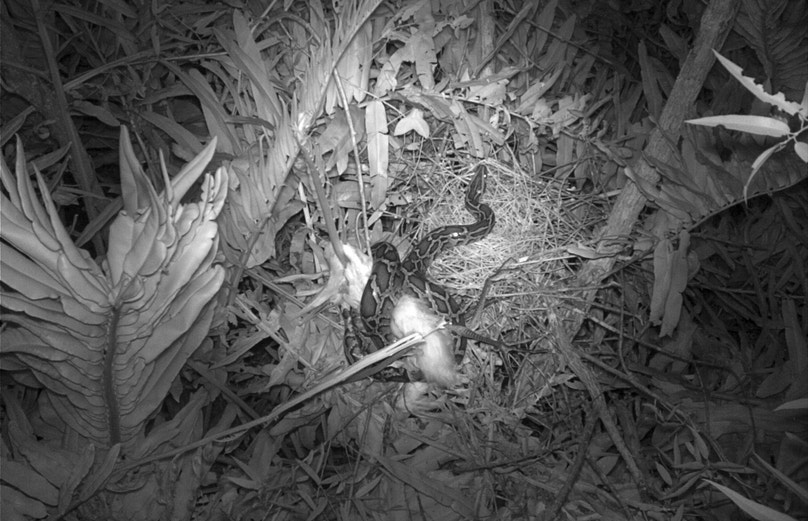
Dense and sweltering, the wild Everglades backcountry is inhospitable to most human endeavor. But for a Burmese python, the living's easy. The invasive predators had established a population in the region by 2000, and have since spread rapidly. They all but wiped out small mammals from Everglades National Park, according to a buzz-making 2012 study. And, as Audubon covered last year, scientists worry that South Florida’s long-legged wading birds—a group whose population has plunged nearly 90 percent in the region over the past century or so—may be emerging as their new dietary staple.
It’s been known for years that the snakes sometimes swallow wading birds whole; necropsies have revealed dozens of avian species in python guts, including Wood Stork, Snowy Egret, and Roseate Spoonbill. But now a pair of new studies deepen those concerns by showing that the serpents aren’t merely picking off the occasional feeding adult, but are targeting the crowded nesting colonies where whole generations of young birds sit defenseless.
“Invasive pythons are now predating in wading bird colonies, which hadn’t been documented or quantified before,” says Sophia Orzechowski, who led both studies as part of her master’s degree at the University of Florida, with help from the U.S. Geological Survey.
In one study, Orzechowski and colleagues used trail cameras to provide the first solid evidence that pythons prey on nestlings and eggs at wading bird colonies. The cameras didn’t capture any such proof in the study’s first two seasons, but in 2017, the snakes raided 5 White Ibis and Great Egret nests out of 125 monitored nests. That might not sound like much, but for comparison, only one of those nests was hit by a native predator—a Great Horned Owl.
The other study sought to find out if pythons are drawn to the tree-covered islands where Everglades wading birds nest. Since that habitat is nearly impenetrable and the snakes are super stealthy, Orzechowski’s team turned to environmental DNA, or eDNA—an emerging tool that lets scientists see if a species has recently used an area based on traces of genetic material it leaves behind. A comparison of water samples from 15 tree islands with active colonies and 15 without suggested that the nesting birds, and not merely the tree-island habitat, attract Burmese pythons—which the other paper proved are nest predators.
“The data they presented is the first confirmation that not only are pythons getting into those rookeries, they’re encountering them more often than would happen on chance,” says Shawn Clem, research director at Audubon’s Corkscrew Swamp Sanctuary. “They’re looking for them.”
Taken together, the studies raise troubling questions about the future for a group of birds that, while vulnerable and in decline, have shown the potential to rebound when conditions are right. Resource managers look to wading birds as indicators to gauge the success of ongoing efforts to restore the historic hydrology of the Everglades ecosystem.
“With Everglades restoration, we’re finally in a place where we can start making a difference that is intended to trickle up to the wading birds,” says Clem, who was not involved in the studies. “So news like this, in light of the hopeful feeling we have from Everglades restoration, is kind of threatening to set us back when we thought we were making progress.”
Introduced to Florida as escaped pets, pythons now slither through the Everglades by the tens or hundreds of thousands. Hunters in state-led python derbies have killed at least a thousand of them, but such efforts aren’t enough to stop the fast-reproducing species from proliferating.
Pythons aren’t just numerous—they’re eating machines that can put away more than their body weight in a single meal. A couple of weeks ago, researchers in Big Cypress National Preserve captured and killed a 17-foot female weighing 140 pounds and carrying 73 eggs. It was the biggest one ever recorded at the park, which is located in the western Everglades.
That behemoth was caught perhaps 50 miles from Corkscrew Swamp, Clem says. The sanctuary is home to what was historically the country’s biggest nesting colony of federally threatened Wood Storks. That colony has been drastically diminished and in some recent years has been vacant, but a successful 2018 nesting season renewed hopes for its future.
Staff at the sanctuary are trained in how to detect and capture pythons, Clem says, and are keeping vigilant watch over the swamp for the secretive snakes. “To date, we don’t have pythons at Corkscrew,” she says. “But they are getting close."

